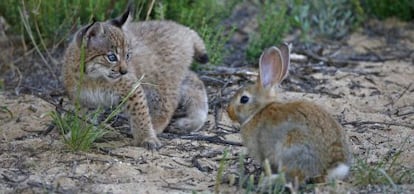Iberian lynx faces new threat as disease decimates rabbit population
33 percent of deaths of the animal are traffic-related, as they are forced to travel in search of prey

The Iberian lynx is running out of prey. The most endangered feline in the world needs at least one rabbit a day to survive, and losing its main source of food could represent a major problem to conservation efforts.
A new strain of the rabbit hemorrhagic disease (RHD), which is affecting all of Spain, now poses a threat to lynx reproduction in the natural park of Sierra de Andújar, a major lynx preserve located in the mountainous Andalusian province of Jaén.
This area already had a low rabbit density but also holds a significant number of fertile lynx females (53 of them were counted last year). In the national park of Doñana, the feline's other major habitat, there are only 25 females but more rabbits.
The lack of food is a problem, because without a full belly a lynx will not turn its thoughts to reproduction, and species recovery plans such as the Life Iberlince program could suffer. The heat season begins now, in December.
Andalusia is working fast on measures to halt the rabbit decline
"We fear that the work of the last 10 years will go to pieces," says Ramón Pérez de Ayala, a World Wide Fund for Nature (WWF) participant in Life Iberlince. The Life programs, which are co-financed by the European Union, have managed to triple the Iberian lynx population in the last decade. The 2012 census tallied 305 specimens.
"I fear that number is going to decline considerably this year, especially in the Jaén area," warns Miguel Ángel Simón, coordinator of the Iberlince project, in which Portugal is also a participant, as well as the Spanish regions of Andalusia, Murcia, Extremadura and Castilla-La Mancha.
Last year, 44 newborn cubs pulled through. This year's figures will not be official until the end of the month, but sources unofficially said that there are no more than 10 young.
If a lynx does not find rabbits in its regular habitat, it may begin to travel in search of them, exposing itself to being hit by a car - 33 percent of these felines die this way. So far this year, 13 lynx have been run over by vehicles.
The young who survive
Treating the new strain of the rabbit hemorrhagic disease (RHD) is a difficult task because so little is known about it yet, and its patterns have yet to be defined.
However, what researchers have found out is that it affects young rabbits less than 30 days old, causing jaundice and nasal hemorrhaging, in a majority of cases fatal.
"Since young rabbits under three months old catch the disease but get immunized and do not suffer it as adults, it would make sense to focus any disease-fighting strategy in Spain on this fact," writes Carlos Calvete, a researcher at the animal health unit of the Center for Agrifood Research and Technology of Aragón (CITA) in one of his papers. Calvete is considered one of Spain's leading experts in the epidemiology of this bleeding disease.
Meanwhile, the Andalusian Hunting Federation is helping the regional authorities by collecting dead rabbits they find in the wild and turning them in for analysis under the Epidemiology Surveillance Program.
The regional government of Andalusia is working fast on special measures to put a stop to the population decline.
"We are going to bring back fencing that was built in 2002 to repopulate [the area] with rabbits and ensure food is not affected," says Simón. But the real effects of the shortage will not be felt until March 2014, when the breeding season begins.
In the last few months, the Andalusian environment department has been monitoring the rabbit populations and confirmed a significant drop in density.
Several sources said that the new strain of the rabbit disease has been detected in 12 of the 13 samples collected in Doñana and Sierra de Andújar. In 2010 and 2011, two other outbreaks of the rabbit viral disease caused a large population drop.
The new strain now adds to the old one, which mainly affects adult rabbits. The most recent form of the disease was first detected in the wild at rabbit farms around about a year ago.
In January, the Environment Ministry will meet with the fauna and flora committee and the hunting committee, as well as with animal health specialists, to find ways to fight this new strain.
Andalusian authorities are also set to call another meeting in February as part of the Iberlince project, which runs on a budget of 34 million euros over the 2011-2016 period. The EU contributes 61 percent of the money, while the rest is put up by the other partners.
Tu suscripción se está usando en otro dispositivo
¿Quieres añadir otro usuario a tu suscripción?
Si continúas leyendo en este dispositivo, no se podrá leer en el otro.
FlechaTu suscripción se está usando en otro dispositivo y solo puedes acceder a EL PAÍS desde un dispositivo a la vez.
Si quieres compartir tu cuenta, cambia tu suscripción a la modalidad Premium, así podrás añadir otro usuario. Cada uno accederá con su propia cuenta de email, lo que os permitirá personalizar vuestra experiencia en EL PAÍS.
¿Tienes una suscripción de empresa? Accede aquí para contratar más cuentas.
En el caso de no saber quién está usando tu cuenta, te recomendamos cambiar tu contraseña aquí.
Si decides continuar compartiendo tu cuenta, este mensaje se mostrará en tu dispositivo y en el de la otra persona que está usando tu cuenta de forma indefinida, afectando a tu experiencia de lectura. Puedes consultar aquí los términos y condiciones de la suscripción digital.
Últimas noticias
Maduro pleads not guilty before the federal court in New York: ‘I am still the president of Venezuela’
A new test can detect Alzheimer’s from a finger prick
UN team enters Sudanese city of El Fasher after paramilitary massacre: ‘It’s like a ghost town’
A recipe for resistance: Indigenous peoples politicize their struggles from the kitchen
Most viewed
- Gilles Lipovetsky: ‘If you want to live better and fall in love, take Prozac, don’t look to philosophy’
- Alain Aspect, Nobel laureate in physics: ‘Einstein was so smart that he would have had to recognize quantum entanglement’
- Alvin Hellerstein, a 92-year-old judge appointed by Bill Clinton, to preside over Maduro’s trial in New York
- Why oil has been at the center of Venezuela-US conflicts for decades
- Cuba confirms death of 32 of its citizens in the US attack against Venezuela









































